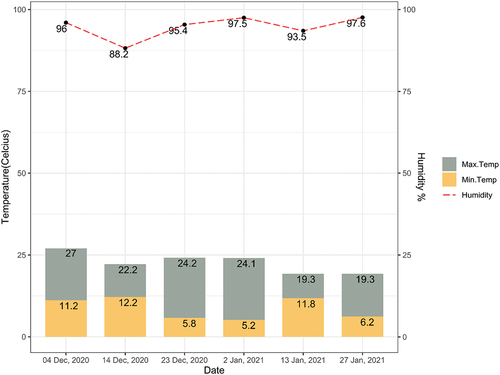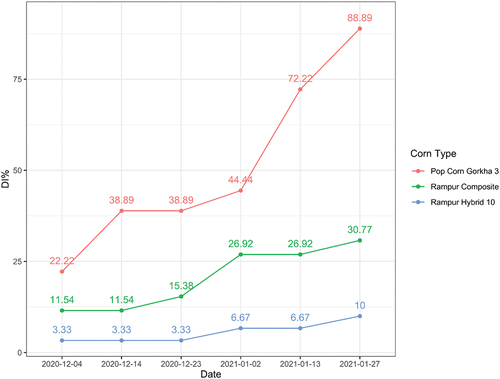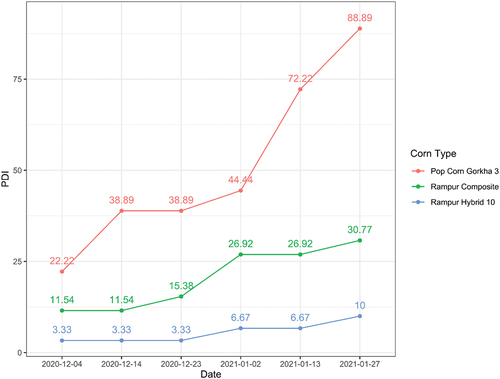 ?Mathematical formulae have been encoded as MathML and are displayed in this HTML version using MathJax in order to improve their display. Uncheck the box to turn MathJax off. This feature requires Javascript. Click on a formula to zoom.
?Mathematical formulae have been encoded as MathML and are displayed in this HTML version using MathJax in order to improve their display. Uncheck the box to turn MathJax off. This feature requires Javascript. Click on a formula to zoom.Abstract
Northern leaf blight (NLB) (Exserohilum turcicum) is the most important among disease of maize in cold and humid areas in Nepal. Environmental factors, particularly temperature and relative humidity, have a significant impact on the development of diseases. With the objective to correlate weather parameters with disease development, the experiment was conducted using three distinct varieties: Popcorn Gorkha 3 (Susceptible check), Rampur Composite (Standard and Local Check), and Rampur Hybrid 10 (Resistant Check). Numerous disease-related variables, including disease incidence percent, percent disease index (PDI), area under the disease progress curve (AUDPC), and the number of infected leaves per sample plant (IL/S), were correlated with mean relative humidity (RH), maximum temperature, and lowest temperature. The disease severity raised from 22.22% to 88.89% in Pop Corn Gorkha 3, from 11.54% to 30.77% in Rampur Composite, and from 3.33% to 10% in Rampur Hybrid 10, when the minimum temperature dropped from 11.2°C to 6.2°C. Correlation coefficient and principal component analysis showed that minimum and maximum temperature were negatively correlated while RH was positively correlated. According to the coefficient of determination (R2), certain meteorological factors contributed 94%–99% to the severity of the condition. The crucial step in developing disease management methods is a systematic examination of the correlation between meteorological variables and disease severity.
Public interest statement
As disease development is contributed by many factors, among them weather is the most important one. It has impact on both pathogen and host. This paper highlights the influence of weather on the development of northern leaf blight of maize.
1. Introduction
Maize (Zea mays L.), a significant annual cereal crop grown around the world and a member of the Poaceae family, is high in nutrients and phytochemicals(Rouf Shah et al., Citation2016). In terms of area and production, it ranks second in importance to rice (Oryza sativa L.) as a main crop in Nepal and is playing an imperative role in combating the issues of food and nutritional security (Bista et al., Citation2013). On 197.20 million hectares of land, 1.14 billion tons of maize are produced, with a production rate of 5.82 t/ha (Food and Agriculture Organization Corporate Statistical Database, Citation2019). It covers an area of 956,447 ha producing 2,713,635 metric tons with the productivity of 2.84 mt/ha in Nepal. The highest production is done in province 1 with 831,378 metric tonnes and the lowest in Sudurpashchim province with 112,225 metric tonnes yield. Illam, Bhojpur, Khotang, Jhapa, Sindhuli, Makawanpur, and Syangja are major maize-producing districts of Nepal (MoALD, Citation2019). Nearly 80% of the maize produced in Terai is used for the poultry and feed industries , but in the hilly area, the bulk of maize is consumed for food and seed (Timsina et al., Citation2016). Each year, national feed manufacturers import 87% of the entire maize used in feed manufacturing from India (Gairhe et al., Citation2021). This exemplifies the change in maize demand toward livestock and poultry feed. During the year 2019/20, Nepal imported maize worth NPR. 13.6 billion; sweet corn (frozen) worth NPR. 19.4 million; maize seed worth NPR. 1.1 billion; maize flour worth NPR. 1.7 million; and maize starch worth NPR. 308 million (Nepal foreign trade statistics, Citation2019/20). It indicates that Nepal’s maize output and productivity are quite low when compared to world yields and that the country’s need is not even met. In Nepal, poor crop management and diseases are the main factors causing the quantity and quality of maize to decline. Among them, Northern leaf blight (NLB) is a devastating foliar disease of maize that needs to be managed effectively in Nepal, as well as in humid and colder maize-growing areas around the world. NLB commonly thrives in mid-altitude tropical as well as the temperate agroecological region where the temperature ranges from 15–30°C with an optimum of 20°C, 14 hours of dew period, high relative humidity (RH) of 90–100%, and low light levels (Levy & Pataky, Citation1992). Small grey-green, oval, and water-soaked spots emerge in lower leaves after 1–2 weeks of infection, then advance to a long (5–20 cm) (Bashir et al., Citation2018), elliptical or cigar-shaped, broadest at center with tapering or serrated end, grayish to tan/dark brown colored lesion running parallel to the leaf margin and advancing to upper canopy over time (CIMMYT, Citation2004). Severe infestation can lead to coalescing of the lesions and the entire leaf appears blighted/necrotic. As the disease progresses, it infects all the leafy structures including husks (Wise, Citation2011). Existing practices for maize improvement and disease management incorporate the utilization of host resistance, chemical management (Payak & Sharma, Citation1985), biological and botanical management, and pathogen elimination by application of good cultural practices that includes farm hygiene, intercropping, residue management, crop rotation, and biotechnological approaches (Mueller et al., Citation2020).
Although there are chemical fungicides that can be used to treat this disease, doing so has risks to people, animals, and the environment. The management of these infected crops is challenging due to the lack of commercially available disease-resistant cultivars, given the significance of the crop and the pathogen’s destructive character. The disease progression curve, also known as the signature of an epidemic, embodies the integration of all host, pathogen, and environmental influences throughout the epidemic (Nwanosike & Mabagala, Citation2017). The environment has a significant impact on the natural epidemics of NLB, and Nepal experiences severe disease every year. The majority of Nepalese cultivars are susceptible to the disease northern leaf blight, and there are no marketable resistant variations. Furthermore, in order to effectively manage the disease through adjusting sowing dates, it is essential to understand the timing of pathogen assault, disease progression, and their relationships to climatic conditions. Inadequate knowledge of the epidemiological characteristics of this disease would be one of the causes. Temperature and RH are crucial environmental elements that influence the development of disease and the spread of an epidemic (TeBeest et al., Citation2008).
To maintain the link between the host and the pathosystem and to stop disease outbreaks, epidemiological research is necessary. The NLB outbreak will now be the subject of extensive research. In order to anticipate and forecast a disease’s future progression in relation to disease incidence and environmental variables, epidemiological studies are essential. In order to ascertain the link between disease development, temperature, and RH, three varieties of maize were studied at Rampur, Chitwan, Nepal, to see how temperature and RH impacted disease parameters.
2. Materials and methods
During the winter of 2020, the experiment was carried out at the Agriculture and Forestry University’s horticulture farm in Rampur, Chitwan. Three varieties i.e., Rampur hybrid 10 (Resistant check), Rampur composite (Standard and local check), and Popcorn Gorkha 3 (Susceptible check) were grown in two long rows of 3 meters with standard packages and practices. The isolation of fungus was made from the diseased leaf samples using the isolation technique described by Shekhar and Kumar (Citation2012). For the uniform disease pressure, the inoculum was sprayed after 35 days of sowing at the concentration of 2.25 × 104 spores/ml during evening. The spore count was done using the new improved Neuber’s counting chamber (Haemocytometer, Marienfeld, Germany). Disease incidence percentage (DI %), percent disease index (PDI), area under disease progress curve (AUDPC), and infected leaves per sample plant (IL/S) were recorded from 10 tagged sample plants at the interval of ten days after 60 days of sowing for the total of six times (Abebe et al., Citation2008).
3. Observation of disease reaction and scoring
Disease assessment was started from the time when 2–3 lesions were spotted in basal leaves using a 0–5 rating scale as given by CIMMYT (Citation1985); Singh et al. (Citation2004) as shown in Table .
Table 1. Disease rating scale of northern leaf blight of maize
4. Estimation of disease incidence percentage
The percentage for disease incidence was calculated by using the formula of Wheeler (Citation1969).
5. Estimation of Percent Disease Index (PDI)
The disease score was converted into the severity percentage by using the formula of Wheeler (Citation1969).
6. Estimation of Area Under Disease Progress Curve (AUDPC)
The AUDPC was calculated using the formula given by Campbell and Madden (Citation1990).
where “t” is the time of each reading, “y” is the percent disease severity at each reading, and “n” is the number of readings.
7. Estimation of infected leaves
The total number of infected leaves was counted from ten tagged sample plants on all six scoring dates. The total number of lesions was also estimated from two leaves (one from the ear and another above ear) of each sample (Abebe et al., Citation2008).
8. Weather data and statistical analysis
Data on temperature and RH under field conditions were procured from the National Maize Research Program (NMPR), Rampur, Chitwan. Metrological data were correlated with the disease development as shown in Figure . The relation among the disease parameters and weather variables (maximum temperature, minimum temperature, and mean RH) during disease development was established by determining the correlation, regression coefficient, and principal component analysis using R and MS Excel 2019.
9. Results and discussion
The data were recorded periodically at the interval of ten days on disease incidence (DI) %, PDI, AUDPC, and IL/S. The progression of these disease parameter periodically of three different varieties are diagrammatically represented in the Figures . These disease characteristics were associated with maximum temperature, minimum temperature, and mean RH, and the correlation coefficients are shown in Tables .
Figure 4. Progression of area under disease progress curve (AUDPC) of different genotypes on different dates.
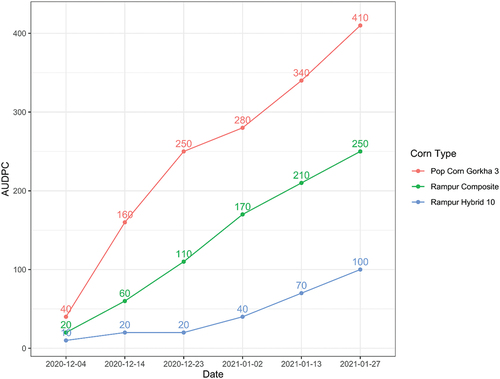
Figure 5. Progression of infected leaves per sample plant (IL/S) of different genotypes on different dates.
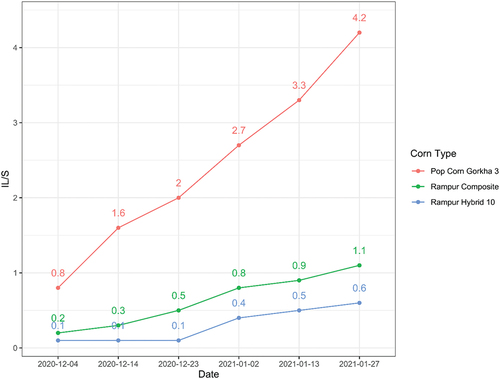
Table 2. Correlation matrix of different weather factors with different disease parameters of Pop Corn Gorkha 3
Table 3. Correlation matrix of different weather factors with different disease parameters of Rampur Composite
Table 4. Correlation matrix of different weather factors with different disease parameters of Rampur Hybrid 10
Table 5. Multiple regression equations of weather factors with mean disease severity (%) or PDI of different genotypes
The disease incidence of 22.22% was recorded on the first day of data collection and reached to 88.89% in Pop Corn gorkha 3 while 30.77% and 10% was recorded in final date in Rampur Composite and Rampur Hybrid 10, respectively. PDI of 88.89% was recorded in Pop Corn Gorkha 3 while 30.77 % and 10% in Rampur composite and Rampur Hybrid 10, respectively, at final date. AUDPC value was increased from 40 to 410 in Pop Corn Gorkha 3, 20 to 250 in Rampur Composite, and 10 to 100 in Rampur Hybrid 10. The number of infected leaves per sample plant (IF/S) was recorded 4.2, 1.1, and 0.6 at final date in Pop Corn Gorkha 3, Rampur Composite, and Rampur Hybrid 10, respectively. Pop Corn Gorkha 3 showed high rate of disease progression followed by Rampur Composite and Rampur Hybrid 10 as shown in Figures .
Maximum temperature raised from fortnight of December to January but reduced from fortnight of January. The disease severity increased significantly from fortnight of January in all the genotypes. As minimum temperature decreased from 11.2°C to 6.2°C, the disease severity increased from 22.22 % to 88.89% in Pop Corn Gorkha 3, 11.54% to 30.77% in Rampur Composite, and 3.33 % to 10% in Rampur Hybrid 10. In the correlation matrix of all the genotypes, maximum temperature was found negatively correlated to all the disease parameters like disease incidence %, PDI, AUDPC, and IL/S. Minimum temperature also showed same results. RH was found positively correlated to all the disease parameters in all the genotypes, although not significantly different. The current study’s findings are consistent with those of Tajudin et al. (Citation2018). Coefficient of determination (R2) showed that particular meteorological factors contributed 94–99% to the severity of the condition. In biplot analysis, principal component 1 (PC1) and PC2 accounted for 84.9% of the total variation. As shown in Figure , disease parameters are positively correlated with each other. RH had positive correlation while maximum and minimum temperature had negative correlation with disease parameters.
Figure 6. Biplot of first and second principal components based on three genotypes including all disease and weather parameters.
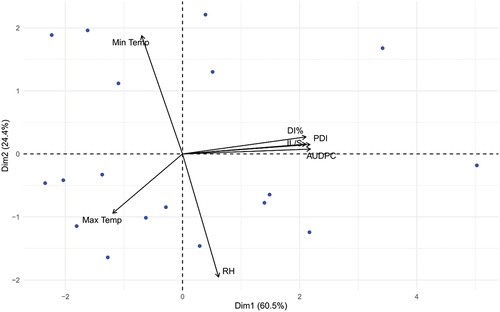
In addition, Reddy et al. (Citation2013) found a positive correlation with high relative humidity and a negative correlation with maximum temperature in terms of disease incidence. They argued that the mean lowest temperature had no influence on the disease’s development. In locations with high humidity and persistent wetness, NLB incidence varies from 95 to 100% and yield loss can reach up to 70% (Tewabech et al., Citation2012). NLB of maize is extensively distributed with varied intensity, according to Nwanosike et al. (Citation2017), with the highest incidence and percent severity index observed at maximum temperatures up to (31–35°C) and high RH (75–100%). The present study’s findings confirm their claims. Previous research (Khedekar et al., Citation2010; Rani, Citation2015) suggested that the primary aspects of the environment throughout the cropping season i.e., RH, maximum and lowest temperatures, would lead to a higher incidence and severity of disease.
RH showed a positive significant correlation coefficient, and there was a negative significant correlation between minimum and maximum temperature and the incidence and severity of the NLB disease in maize. These correlations showed that environmental factors were directly linked to the development of the disease in maize. Regression coefficients that were significant also supported the existence of a robust correlation between environmental variables and NLB development. The results corroborated those of Harlapur (Citation2005), who found a substantial positive link between cumulative rainfall, RH, and illness intensity as well as a significant negative relationship between disease intensity and minimum and maximum temperatures. This study also supported the findings of Pandurangegowda et al. (Citation1993) and Rai et al. (Citation2002), who found that NLB on maize was more likely to spread horizontally and vertically in environments with frequent rainfall, high RH, and low temperatures.
10. Conclusion
The findings supported the notion that NLB was more likely to occur under certain climatic conditions. Therefore, it is clear that the development of northern leaf blight on maize throughout the growing season had negative association with minimum temperatures and maximum temperatures while positively associated with relative humidity. Multi-year and multi-location evaluations are required where maize is grown in order to comprehend the behavior of the pathogen over time and to allow disease forecasting for long-term disease management and maize production.
Correction
This article has been corrected with minor changes. These changes do not impact the academic content of the article.
Novelty statement
The trajectory and intensity of epidemics are largely influenced by weather conditions. Therefore, it is necessary to research the effects of various climatic variables, particularly temperature and relative humidity, on the development of Northern leaf blight of maize.
Acknowledgments
I would like to thanks all the personnel of Department of Plant Pathology, Agriculture and Forestry University for managing the trial. I would also like to thanks Dr. Sundar Man Shrestha, Dr. Hira Kaji Manandhar, Mr. Ritesh Kumar Yadav and Mr. Suk Bahadur Gurung for their valuable suggestion and guidance.
Disclosure statement
No potential conflict of interest was reported by the author.
Additional information
Funding
Notes on contributors

Shishir Sharma
Shishir Sharma is currently working as a Campus chief/Assistant professor of Plant Pathology at Purwanchal Agriculture Campus, affiliated to Agriculture and Forestry University, Rampur. The author has interest to work on isolation and identification of phytopathogenic fungi. Integrated disease management, cultural and morphological characteristics of pathogens are his research interest. He had also worked as Research assistant at National Maize Research Program, Rampur.
References
- Abebe, D., Singburaudom, N., Sangchote, S., & Sarobol, E. (2008). Evaluation of maize varieties for resistance to northern leaf blight under field conditions in Ethiopia. Agriculture and Natural Resources, 42(1), 1–10.
- Bashir, K. A., Kamaruzaman, S., & Khairulmazmi, A. (2018). First report of northern corn leaf blight disease caused by Exserohilum turcicum on Zea mays in Malaysia. Journal of Molecular and Genetic Medicine: An International Journal of Biomedical Research, 12(4), 387. https://doi.org/10.4172/1747-0862.1000387
- Bista, D., Amgain, L., & Shrestha, S. (2013). Food security scenario, challenges, and agronomic research directions of Nepal. Agronomy Journal of Nepal, 3(March), 42–52. https://doi.org/10.3126/ajn.v3i0.8985
- Campbell, C. L., & Madden, L. V. (1990). Introduction to plant disease epidemiology. John Wiley & Sons.
- CIMMYT. (1985). Managing trials and reporting data for CIMMYT’s International maize testing program. CIMMYT, El Batan,
- CIMMYT. (2004). Maize Diseases: A Guide for Field Identification (4th ed.).
- FAOSTAT. (2019). On-line database URL [Retrieved September 14, 2021] from http://www.fao.org/faostat/en/#data/QC
- Gairhe, S., Timsina, K. P., Ghimire, Y. N., Lamichhane, J., Subedi, S., & Shrestha, J. (2021). Production and distribution system of maize seed in Nepal. Heliyon, 7(4), e06775. https://doi.org/10.1016/j.heliyon.2021.e06775
- Harlapur, S. I. (2005). Epidemiology and management of turcicum leaf blight of maize caused by Exserohilum turcicum (Pass.) Leonard and Suggs. Ph.D. Thesis, Univ. Agric. Sci.
- Khedekar, S. A., Harlapur, S. I., Kulkarni, S., & Benagi, D. V., VI. (2010). Integrated management of turcicum leaf blight of maize caused by Exserohilum turcicum (Pass.) Leonard and suggs. Karnataka Journal of Agricultural Sciences, 23(2), 372–373.
- Levy, Y., & Pataky, J. K. (1992). Epidemiology of northern leaf blight on sweet corn. Phytoparasitica, 20(1), 53–66. https://doi.org/10.1007/BF02995636
- MoALD. (2019). Statistical information on nepalese agriculture 2075/76 (2018/19), government of nepal, ministry of agriculture and livestock development. Singha Durbar.
- Mueller, D. S., Wise, K. A., Sisson, A. J., Allen, T. W., Bergstrom, G. C., Bissonnette, K. M., Bradley, C. A., Byamukama, E., Chilvers, M. I., Collins, A. A., Esker, P. D., Faske, T. R., Friskop, A. J., Hagan, A. K., Heiniger, R. W., Hollier, C. A., Isakeit, T., Jackson-Ziems, T. A., Jardine, D. J. … Wiebold, W. J. (2020). Corn yield loss estimates due to diseases in the United States and Ontario, Canada, from 2016 to 2019. Plant Health Progress, 21(4), 238–247. https://doi.org/10.1094/PHP-05-20-0038-RS
- Nepal foreign trade statistics. (2019/20). Department of customs,Ministry of Finance. Tripureshwor.
- Nwanosike, M. R. O., & Mabagala, R. B. (2017). Influence of metrological parameters on the development of Exserohilum turcicum (Pass.) Leonard and Suggs on maize in Tanzania. International Journal of Agricultural and Food Research, 6(3), 466–475.
- Pandurangegowda, K. T., Shetty, H. S., Jayaramegowda, G., & Sangamlal. (1993). Incidence of turcicum leaf blight of maize in southern Karnataka. Current Research, 22, 100–101.
- Payak, M. M., & Sharma, R. C. (1985). Maize diseases and approaches to their management in India. Tropical Pest Management, 31(4), 302–310. https://doi.org/10.1080/09670878509371006
- Rai, B., Kumar, S., & Kumar, B. (2002). Effect of environmental parameters on the development of turcicum leaf blight of maize. Annals of Biology, 18(2), 153–155.
- Rani, S. (2015). Epidemiology and Management of Turcicum Leaf Blight (Exserohilum Turcicum (Pass) Leonard and Suggs) Of Maize In Jammu Sub-Tropics (PhD Thesis of of Plant Pathology) Sher-e Kashmir University of Agricultural Sciences & Technology of Jammu, pp. 1–123.
- Reddy, T. R., Reddy, P. N., & Reddy, R. R. (2013). Survey of Turcicum Leaf Blight of Maize in major maize growing areas of Andhra Pradesh. International Journal of Applied Biology and Pharmaceutical Technology, 3(10), 273–276.
- Rouf Shah, T., Prasad, K., Kumar, P., & Yildiz, F. (2016). Maize—A potential source of human nutrition and health: A review. Cogent Food and Agriculture, 2(1), 1–9. https://doi.org/10.1080/23311932.2016.1166995
- Shekhar, M., & Kumar, S. (Ed.). (2012). Inoculationtechniques anddisease ratingscales formajordiseases ofmaize. Directoriate of maize research. Pusa campus.
- Singh, R., Mani, V. P., Koranga, K. S., Bisht, G. S., Khandelwal, R. S., Bhandari, P., & Pant, S. K. (2004). Identification of additional sources of resistance to Exserohilum turcicum in maize (Zea mays L.). SABRAO Journal of Breeding and Genetics, 36(1), 45–47.
- Tajudin, A., Alemayehu, C., & Netsanet, B. (2018). Survey of Turcicum leaf blight (Exserohilum turcicum) on maize (Zea mays) in major highland and mid-altitudes of maize growing agro-ecologies of Western part of Oromia, Ethiopia. African Journal of Plant Science, 12(10), 264–276. https://doi.org/10.5897/AJPS2018.1692
- TeBeest, D. E., Paveley, N. D., Shaw, M. W., & Van Den, B. F. (2008). Disease–Weather relationships for powdery mildew and yellow rust on winter wheat. Phytopathology, 98(5), 609–617. https://doi.org/10.1094/PHYTO-98-5-0609
- Tewabech, T., Dagne, W., Girma, D., Meseret, N., Solomon, A., & Habte, J. (2012). Maize pathology research in Ethiopia in the 2000s. In Mosisa Worku Twumasi Afriyie, S., W. Legese, B. Tadesse, D. Girma, B. Gezahing, W. Dagne, & B. Prasanna (Eds.), Meeting the challenges of global climate change and food security through innovative maize research. proceedings of the 3rd national maize workshop of Ethiopia.18-20 April 2011 (pp. 193–201). Addis Ababa.
- Timsina, K. P., Ghimire, Y. N., & Lamichhane, J. (2016). Maize production in mid hills of Nepal: From food to feed security. Journal of Maize Research and Development, 2(1), 20–29. https://doi.org/10.3126/jmrd.v2i1.16212
- Wheeler, B. E. J. (1969) . An Introduction to Plant Diseases (pp. 374).
- Wise, K. (2011). Diseases of Corn: Northern corn leaf blight. Purdue Extension, 6, 1–3

